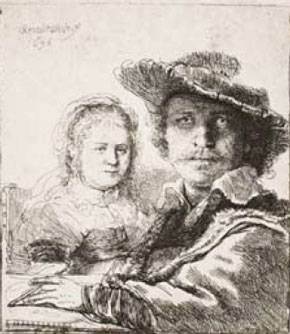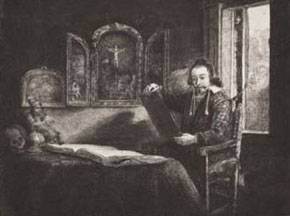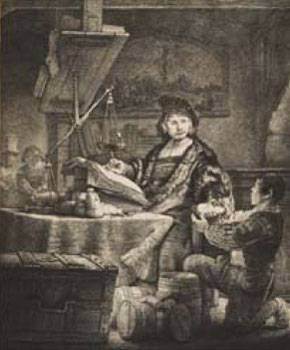
Rembrandt van Rijn, Dutch, 1606–1669
Self-Portrait with Saskia, 1636
Etching, State I
plate: 4-1/8 x 3-11/16 in. (10.5 x 9.4 cm);
sheet: 4-1/4 x 3-3/4 in. (10.8 x 9.5 cm)
Norton Simon Art Foundation

Rembrandt van Rijn, Dutch, 1606–1669
Abraham Francen, Apothecary, c.1657
Etching, drypoint, burin; State VII
plate: 6-1/4 x 8-3/16 in. (15.9 x 20.8 cm);
sheet: 6-5/8 x 8-5/16 in. (16.8 x 21.1 cm)
Norton Simon Art Foundation

Rembrandt van Rijn, Dutch, 1606–1669
Jan Uytenbogaert, ‘The Goldweigher’, 1939
Etching, drypoint; State II
plate: 9-3/8 x 7-15/16 in. (23.8 x 20.2 cm);
sheet: 10 1/16 x 8 1/8 in. (25.6 x 20.6 cm)
Norton Simon Art Foundation
The Familiar Face: Portrait Prints by Rembrandt
The Norton Simon Museum presents The Familiar Face: Portrait Prints by Rembrandt, anexhibition of 15 etchings by Dutch master Rembrandt van Rijn (1606–1669). Rembrandt’s prominence as apainter of portraits, particularly those of the merchants and burghers of Amsterdam, is well known. But theartist’s etched prints also have a place and purpose in recording the visages of his contemporaries. A skilled,innovative printmaker, Rembrandt embraced etching as a means of expression and experimentation. Theartworks in The Familiar Face illustrate the artist’s keen power of observation as well as his gift for dramaand humor.
December 4, 2009–March 22, 2010
]]>
Source: Norton Simon Museum
Culled from the Norton Simon’s extensive collection of Rembrandt prints, theartworks on view offer a window to some of the personalities of Rembrandt’s age.Although 17th-century Holland had an active trade in the portraits of politicians,heroes and renowned scholars, the majority of portrait prints made by Rembrandtwere not intended for such a market. We know this because his prints do not bear thecharacteristic etched captions identifying the name and public role of the subject.
Rembrandt’s portrait of Petrus Sylvius in all likelihood was commissioned as amemento for Sylvius’s friends and family in Amsterdam. Sylvius, a newly ordained preacher, was about todepart for his first ministry in Friesland, in the northern Netherlands. Another work, an etching of JanUytenbogaert, “The Goldweigher,” is presumed to have been produced by the artist as an act of gratitude.Uytenbogaert, the Receiver-General (or tax accountant) for the province of Holland, was a collector of printsand drawings, and he hosted many painters and poets in his Amsterdam house. In 1639, he assistedRembrandt in receiving payment for paintings the artist had completed for Frederick Henry, the Prince ofOrange. Perhaps not coincidentally, Uytenbogaert’s portrait etching bears the date 1639.
Several etched examples of Rembrandt’s self-portraits are also included in theexhibition. A composition from 1636 depicts a confident 30-year-old Rembrandtdrawing, with his wife, Saskia, alongside him. Twelve years later, he portrayed himselfagain at work, but more reflectively, sitting in a shadow-filled interior illuminated onlyby an open window.
Together, the 15 works presented in The Familiar Face shed light on Rembrandt’sworld and introduce us to some of his friends, family members and contemporaries. The exhibition addressesthe function of these portrait prints, whether they were commissioned, created at the artist’s initiative, orperhaps done as a meditation on the visage of a loved one. Biographies of the sitters are included when known.
The Familiar Face, organized by Gloria Williams Sander, Curator at the Norton Simon Museum, is one ofseveral exhibitions held this winter to celebrate the wealth of Rembrandt’s works in Southern Californiamuseum collections. Rembrandt exhibitions are also being presented by the J. Paul Getty Museum, theTimkin Museum of Art, the San Diego Museum of Art and the Hammer Museum at UCLA. Moreinformation can be found at rembrandtinsocal.org.
Follow us on:


